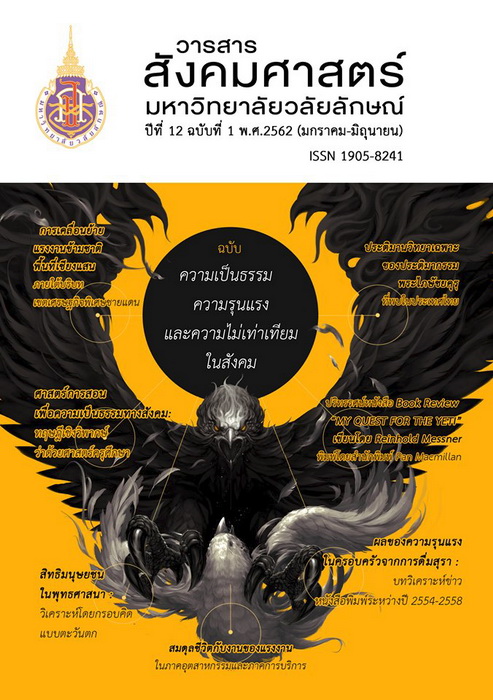Iconography of Phra Bhaisajyaguru Sculpture in Thailand
Main Article Content
Abstract
Phra Bhaisajyaguru Vaitoonprapha or Phra Bhaisajyaguru, also knownas the Medicine Buddha (God of Medicine) is one of the Buddha inBuddhism. In the old days, Phra Bhaisajyaguru was not widelyrecognized, and sculpture of this Medicine Buddha was neverdiscovered in India where Buddhism originated.
When the belief related to the Medicine Buddha spread to China,the establishment of Phra Bhaisajyaguru became more clearly definedand appeared in the scriptures which recorded the determination ofPhra Bhaisajyaguru, the methodology of image creation and buildingsfor the Buddha image to be situated. This belief was extensivelydistributed to Japan, Tibet, Cambodia, and Thailand.
In Thailand, the belief of Phra Bhaisajyaguru appeared in 3 periods.
1. In 18th Century when Thailand was influenced by Cambodia during the reign of King Jayavarman VII. Phra Bhaisajyaguru’s images found inThailand were similar to the image form of Buddha sheltered in Nagahood influenced by the belief of the Khmer culture.
2. The second period, Phra Bhaisajyaguru was found during the Reignof King Rama 5 (King Chulalongkorn) of Bangkok Period.
3. The third period was during between 2007 and 2016 in the reignof King Rama 9, Phra Bhaisajyaguru’s images were combined withTheravada Buddhism belief which resulted in having the imagescreated in varied formations. However, Thai Buddhism arts are morerevealed, such as the Thai facial structure and robed which appearedsimilar to Thai Buddhist monks.
In Thailand, the representation of Thai Buddhist arts is in accordanceof iconology of Phra Bhaisajyaguru’s image which comprised of Thaifacial structure, accessories, and robes. In essence, Phra Bhaisajyaguru’simage has a pot of medicine on the palm of the image as the significanticonology.
Article Details
Copyright: CC BY-NC-ND 4.0
References
________. (1995). Art in Thailand [Sinlapanaiprathedthai]. Krungthep: Rōngphimmahā witthayālaithammasāt.
________. (2004). Khmer Art [Sinlapakhō̜m]. Krungthep: Amarin Printing & Publishing Public Company Limited.
Chatsuma, K. (1986). Phaisatyākhuruwaithūnyapraphātathāsutra. Krungthep: Sawǣngsutthikānphi.
Chinnikai, K. (1988). Phutsātsanāmahāyān. Krungthep: Mūnnithisang khapra chānukhro̜.
Chit, P. (1982). Tamnānhǣngnakornwat. Krungthep: Bō̜ risatsāmak khīsān.
Chutiwongs, N. (1984). The Iconography of Avalokitesvara in Mainland of South East Asia. Leiden, Netherlands: Leiden.
Cleary, T. (1993). The Flower Ornament Scripture: A Translation of the Avatamsaka Sutra. Shambhala USA, Boston: Shambhala Publications. Inc.
Freeman, M. (1996). A guide to Khmer Temples in Thailand & Laos. Bangkok: Amarin Printing and Publishing Public Co. Ltd.
Gordon, A. K. (1959). The Iconography of Tibetan Lamaism. Tokyo, Japan: Ryuseisha Co.
Jittra, K. (1999). Phraphut Phraphōthisat Singsaksitkhō̜ ngčhīn. (phim khrangthī Sām). Krungthep: Samnakphimjittra.
Phasuk, I. (1987). Mahayana Iconography [Phutsātsanālæpratimānavitthaya]. Nakhō̜ npathom: Rōngphimmahāwitthayālaisinpāk.
Phiksuni, K. W. (1979). Prawatkhuruwaithūnyapraphātathākhotčhao.Krungthep: Sūtpaisalkānphi.
Phiksuni, T. (2016). Prawatwatsongthamkanlayanee. Krungthep:Sūtpaisalkānphi
Phitsanuphong, P, & Supaporn Pitiphon, S. (1994). Rōngphayābānkapsamun phraisamaidưkdamban: Čhākjaruek Phračhaochaiwō̜ ramanthī Čhetthīphopnai prathedthai. Sinlapawatthanatham 15(5), 1-10.
Phraichayachit, S. (1993). Arōkhayasānrōngphayābānkhō̜ m. Siamaraya,2(10),1-10.
Shewasukthaworn, W. (2015). The Change of Chapel of Arogayasala’sUsage Patterns: A Case Study of Northeastern Thailand.Najua, 12, 46-69.
Somdetkromphraya, D. (1976). Tumnanbudhajedi [Tamnān phraphutčhēdī]. Krungthep: Samnakphim sinlapābannākhān.
Suphattharadit, D. (1972). Khmer Sculpture [Pratimākamkhō̜m].Krungthep: Krungsiamkānphi.
Thongdaeng, W., & Thongpan, S. (2004). Sāmsip Arōkyasālā: Rōngphayābān khō̜ mnaimummō̜ ngchāobān.Wansanmuangboran, 30(3), 1-10.
Thossaphol, C. (2015). Phra Bhaisajyaguruvitulyaprapa [khuruwaithūnya praphātathākhot]. Krungthep: Comma PublicationCompany Limited.
Thummakon, D. (2008). khō̜ khithenbāngprakānkīaokapprāsātbānsamrōng Jaruekprāsātphrakhanlæ ʻAmnātkānmư̄ angkhō̜ ngphračhaochaiwō̜ ramanthī Čhet. Wānsānmư̄ angbōrān.


